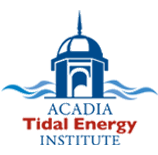Environmental Monitoring, Modelling and Forecasting Infrastructure for Instream Tidal Energy
Project Lead Investigator: Dr. Richard Karsten, Department of Mathematics & Statistics, Acadia University
Project Partners: Acadia University, Dalhousie University, University of New Brunswick, Canadian Foundation for Innovation, Province of Nova Scotia, Province of New Brunswick
Project Manager: Elizabeth Nagel (2018-2019)
Project Total: $2.8 Million
Project Goal: This project will combine the necessary equipment and scientific expertise to carry out the research, generate the evidence and inform the critical decisions necessary to mitigate technological, market, environmental and regulatory risks of tidal energy development in the Bay of Fundy. This research has received a CFI Innovation Fund award to pursue two research themes: impact of turbines on the environment, and impact of the environment on turbines.
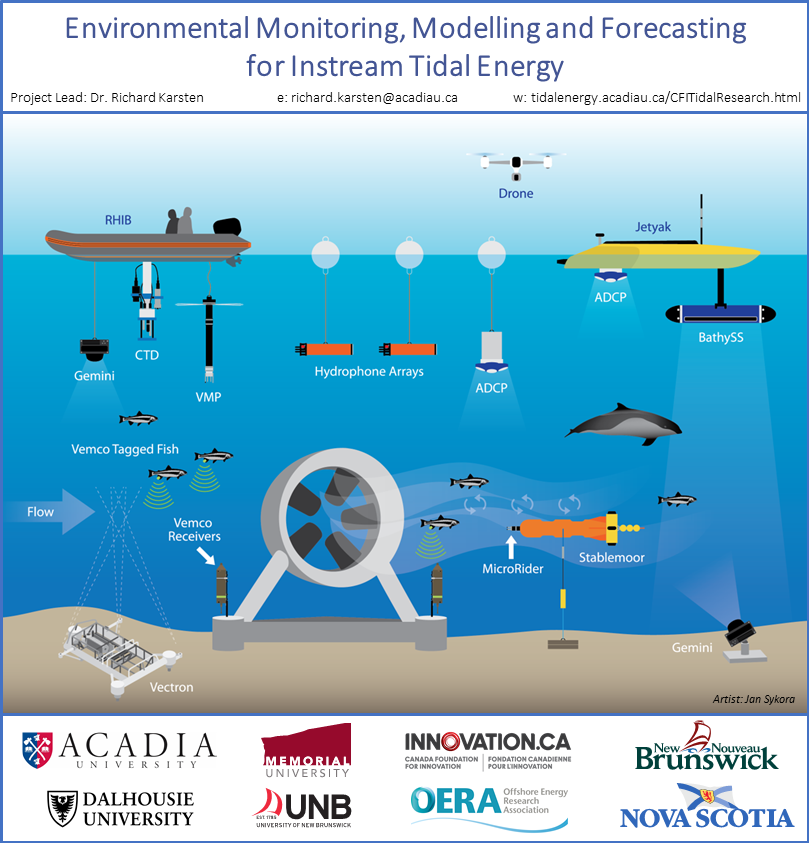
Project Updates
Acadia-led tidal energy research team receives CFI Innovation Fund award (12 October 2017)
EIMR International Conference in Orkney, UK
April 24-27 2018
The third Environmental Interactions of Marine Renewable Energy Technologies (EIMR) Conference was held in Kirkwall, Scotland, and drew together scientists internationally to discuss interactions with the environment to support a sustainable industry. The CFI Project was exhibited as a poster during the conference, and Dr. Anna Redden from ATEI also presented on calculating fish abundance and probabilities of fish-turbine encounters in the Minas Passage and Minas Basin.
The full conference workshop proceedings can be found on the Tethys knowledge base.
12th Bay of Fundy Science Workshop
May 9-12 2018
The 12th Bay of Fundy Ecosystem Partnership (BoFEP) workshop was held in Truro, Nova Scotia and included sessions on tidal power, fisheries ecology, coastal management and restoration and marine contaminants. Elizabeth Nagel presented an overview of the CFI Project to workshop attendees. Dr. Michael Stokesbury presented new fish tracking studies using high-residency tagging technology, and Dr. Anna Redden discussed results from acoustic fish tracking studies at the FORCE test site.
The workshop proceedings can be found here.
CFI Workshop on Turbulence held in Pictou, Nova Scotia
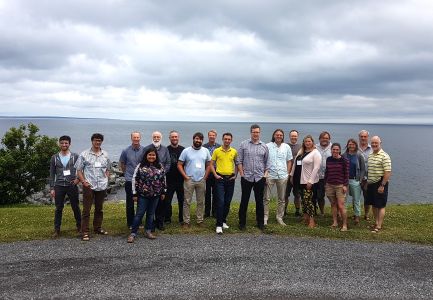
July 16-18 2018
The CFI Connector: Measuring and Modeling Turbulent Tides workshop was organized by Acadia University, and held in early July at Pictou Lodge in Nova Scotia. This three day workshop provided an opportunity for researchers from institutions across Atlantic Canada and abroad (UK, USA) to collaborate with industry and international experts to build on existing research projects and develop new projects using the equipment that will be purchased through the multi-institutional Canadian Foundation for Innovation (CFI) funded project.
The workshop began with members of industry providing detailed updates on current tidal energy projects, as well as outlining challenges and knowledge gaps in tidal turbulence measurement and modeling. Once industry needs were identified, workshop attendees and industry members worked together to develop a top-3 list of prioritized research questions and next steps.
Modelers from Canada and the UK outlined the capabilities and challenges to the field of tidal energy modeling, including plans for the new High Performance Computing (HPC) infrastructure to be purchased as part of the CFI project. Later sessions were dedicated to outlining current and future turbulence measurement programs in Canada and the UK as well as discussing new equipment capabilities. An overview of the CFI project was presented, and feedback was gathered from attendees on plans to deploy CFI equipment over the next 5 years.
Thank you to our sponsors for their support of this workshop, including the Offshore Energy Research Association and Springboard Atlantic.
We also acknowledge the support of the Natural Sciences and Engineering Research Council of Canada (NSERC).
Cette recherche a été financée par le Conseil de recherches en sciences naturelles et en génie du Canada (CRSNG).
Project Summaries
3D Fish tracking and fish-turbine interactions
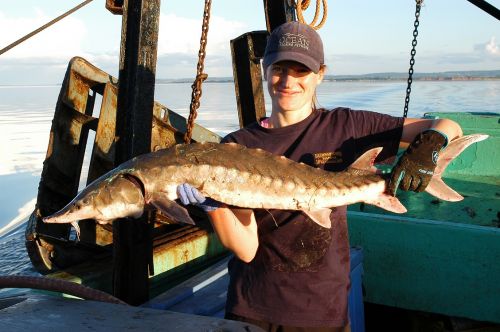
Investigators: Dr. Michael Stokesbury (lead), Dr. Anna Redden, Dr. Richard Karsten
Cutting edge High Residency (HR) VEMCO fish tags engineered for high flow environments will be used to track Atlantic salmon, alewife, American shad and Atlantic sturgeon in the Minas Passage using an array of acoustic receivers.
The high resolution of these data will enable future 3D tracking of fish movement in and around the FORCE site. Tagging results will inform the development of models of fish behaviour near tidal turbines
Acoustic detection of fish and marine mammals
Investigators: Dr. Anna Redden (lead), Dr. Len Zedel, Dr. Michael Stokesbury, Dr. David Barclay, Dr. Richard Karsten
Tritech Gemini imaging sonar will be deployed to assess the presence, vertical distribution and movement of fish and marine life at tidal energy test sites. Simultaneous sonar datasets will be compared between sites with and without turbines to asses critical near-field (<50m) turbine effects.
Other objectives include validating datasets from FORCE’s ongoing echosounder fish surveys, detecting and localizing marine mammals using passive acoustic recordings and simulating fish behaviour near tidal turbines.
Measuring and simulating the acoustic environment
Investigators: Dr. Joseph Hall and Dr. David Barclay
A drifting hydrophone array will be used to quantify the spatial and spectral distribution of turbine-generated noise and propagation. The sound field will be decomposed into natural (biological and environmental) and anthropogenic (turbine and industrial) components.
Simulations of turbine generated noise, supported by computational fluid dynamics (CFD) models from the turbulence project will be used to estimate exposure levels and explore design changes to minimize the impact of turbine noise on marine life.
Quantifying, characterizing and simulating tidal turbulence
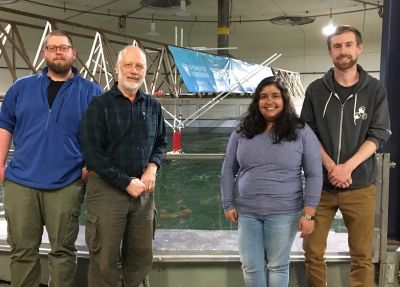
Investigators: Dr. Alex Hay (lead Dalhousie) and Dr. Andrew Gerber (lead UNB), Dr. Len Zedel, Dr. David Barclay, Dr. Paul Hill, Dr. Joseph Hall, Dr. Tiger Jeans, Dr. Richard Karsten
Mobile equipment will be used to quantify the spatial and temporal variation of flow and turbulence in both Grand Passage and Minas Passage. Equipment includes drone-borne video, the Jetyak for mapping wakes and bathymetric sidescan sonar for mapping seabed changes over time. Stationary measurement systems will be deployed to provide complimentary data. These include the Stablemoor/ MicroRider to measure the wake field downstream of turbines throughout the tidal cycle.
High resolution regional and turbine-level CFD simulations of 3D turbulent flow and of turbines will be developed, including unsteady forces and noise to quantify impacts on turbines. Simulations will be validated against measurements from the field.
Ocean forecasting for the Bay of fundy
Investigators: Dr. Richard Karsten (lead), Dr. Andrew Gerber, Dr. Tiger Jeans, Dr. Alex Hay
Advanced research computing (ARC) equipment from ACENET will be used to run regional-level simulations of tides and tidal currents. Designs of turbines and environmental impacts will be assessed through extra-high resolution environmental simulations, in order to improve efficiency and reduce turbine impacts. The effects of weather, waves and turbines on tidal currents will be simulated to support the development of real-time forecasts of sea conditions in order to plan field campaigns and tidal turbine deployments.
